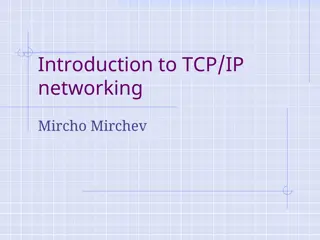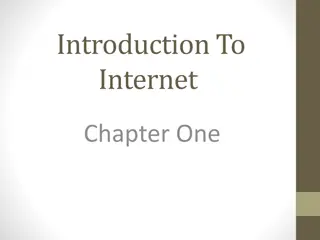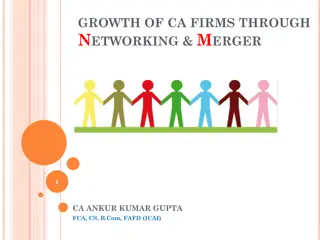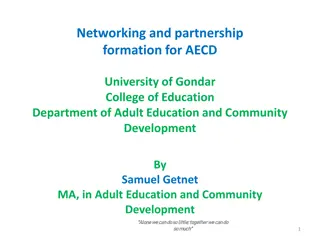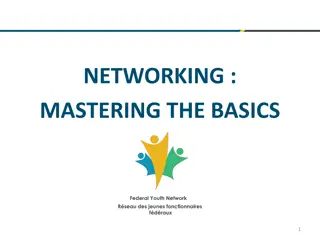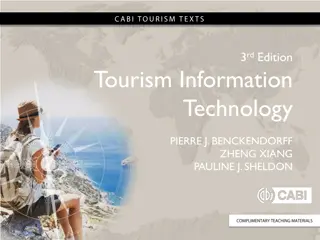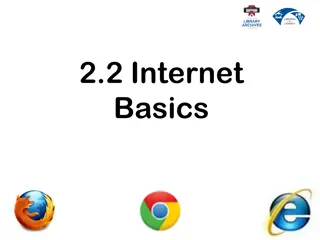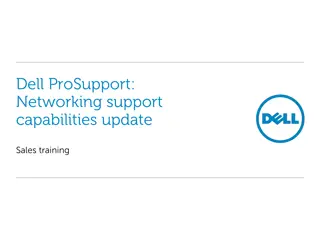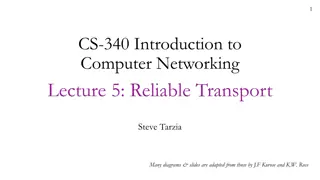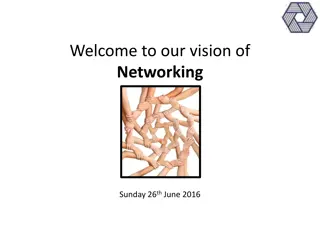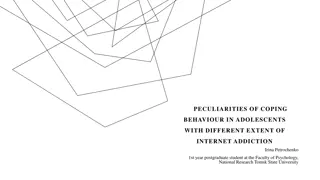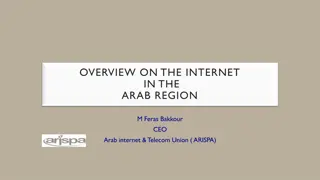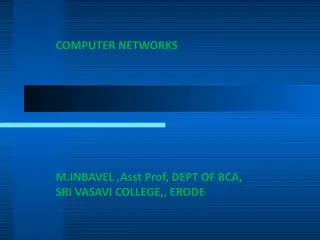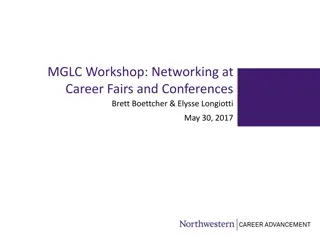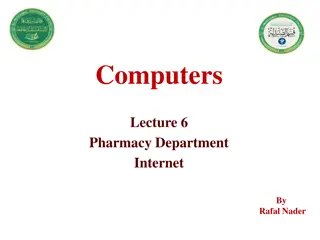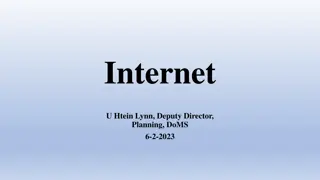Basics of Networking Communication and Internet Structure
The content covers the basics of networking communication, including synchronous and asynchronous communication, broadcast, multicast, and point-to-point communication. It also discusses internet properties, client/server structure, and interactions in client/server relationships. The visuals provide a clear understanding of these concepts.
Uploaded on Sep 22, 2024 | 0 Views
Download Presentation

Please find below an Image/Link to download the presentation.
The content on the website is provided AS IS for your information and personal use only. It may not be sold, licensed, or shared on other websites without obtaining consent from the author.If you encounter any issues during the download, it is possible that the publisher has removed the file from their server.
You are allowed to download the files provided on this website for personal or commercial use, subject to the condition that they are used lawfully. All files are the property of their respective owners.
The content on the website is provided AS IS for your information and personal use only. It may not be sold, licensed, or shared on other websites without obtaining consent from the author.
E N D
Presentation Transcript
Lecture 3 The Basics of Networking
Comparing Communication Types Basic communication vocabulary Synchronous Communication Asynchronous communication Broadcast Multicast Point-to-point communication
General Communication Synchronous communication Both sender and receiver active at same time Example? Asynchronous communication Sending and receiving occur at different times Example?
General Communication Based on number of receivers Broadcast communication: single sender and many receivers (example?) Multicast: many receivers, but usually a specific group (mailing list) Point-to-point communication: one specific sender and one specific receiver (example?)
Internets Communication Properties Internet supports point-to-point, asynchronous communication Internet provides a general communication fabric
Internets Communication Properties Internet is fast enough to mimic synchronous communication Multicasting is also possible Chat rooms Streaming video accessible by anyone (broadcasting)
Client/Server Structure Server stores info; client requests it Most interactions (like loading web page) over the Internet use client/server interaction protocol Click Web link Client, requests page (file) from server Web server responds with page contents Client/server relationship ends
Client/Server Structure Relationships are brief, so a server can serve many clients at the same time Ask, receive, done Yahoo, Google, eBay One client computer can ask for services from many servers
Getting More Connected Internet is primarily a point-to-point asynchronous communication system Software has been built to implement the many forms of communication E.g., Skype slices up signals from computer s microphone and video camera into packet-size blocks
Getting More Connected Content is transferred to other party, whose client reassembles sound and image Process relies on fast and reliable transmission
Computer Addresses IP Addresses Each computer connected to Internet has unique address Series of four numbers separated by dots E.g., 166.66.86.42 Range of each number is 0 255 How many possible addresses?
Computer Addresses Domain Names IP addresses hard to remember Internet uses symbolic names for computers based on a hierarchy of domains A domain is a related group of networked computers
Computer Addresses Domain Names Example: turing.cs.millersville.edu Name of computer is turing Part of the CS department domain (cs) Part of the MU domain (millersville) Which is part of the educational domain (edu)
Computer Addresses Domains are hierarchical Each is a member of the next larger domain edu is a peer of other top-level domains such as com
DNS Servers Domain Name System (DNS) translates hierarchical, human-readable names into IP addresses Every Internet host knows the IP address of its nearest DNS name server Hostname needs to be translated to IP address by DNS server for communications
DNS Servers DNS uses client/server model Name is sent to closest DNS server If not on DNS server, it contacts an authoritative name server (ANS) ANS has complete list of IP address/domain name mappings for all computers in its domain Server returns address
DNS Servers Root name servers know addresses of name servers for edu, com, org, etc. domains Their addresses are preprogrammed into your computer s net software Servers listed at www.root-servers.org (13 + mirrors)
Top-Level Domains Top-level domain names (TLDs) .edu for educational groups .com for commercial enterprises .org for organizations .net for networks .mil for the military .gov for government agencies
Top-Level Domains TLDs were expanded to include biz, info, name, travel, etc. Full list can be found at www.icann.org (ICANN is Internet Corporation for Assigned Names and Numbers)
Top-Level Domains Also country code TLDs (ccTLDs) ca (Canada) uk (United Kingdom) fr (France) Allow domain names to be grouped by their country of origin
Following Protocol Protocol describes the specific technical steps involved in a communication TCP/IP (Transmission Control Protocol/Internet Protocol) is key protocol used on Internet
TCP/IP TCP/IP Postcard Analogy Internet communication is like sending a novel to your publisher using postcards Novel is broken into small units that fit on a postcard postcards are numbered to indicate where each belongs in the novel As each postcard is completed, it is mailed
TCP/IP TCP/IP Postcard Analogy Your publisher eventually receives postcards, but not necessarily in sequential order Nor do they take the same route Cards are finally ordered These postcards are really IP packets They hold: one unit of information, the destination IP, and their sequence number (which packet they are)
Packets Are Independent Each TCP/IP packet can take different route Congestion and service interruptions do not delay transmissions The TCP/IP protocol works under adverse conditions Under heavy traffic packets may be dropped
Packets Are Independent If a packet is dropped, recipient can request a resend Packets can arrive out of order
Moving Packets: Wires & More Internet uses telephone carriers for long-distance connections fiber optics (e.g., see http://www.submarinecablemap.com/) dedicated lines for connections Transmissions may rely on multiple technologies
Far and Near: WAN and LAN Internet is a collection of wide area networks (WAN) Machines aren t geographically close Internet is a collection of point-to-point channels Packets take several must visit a sequence of computers (or hops) before they reach their destination
A ping is a please reply message See ping.eu or network-tools.com
Far and Near: WAN and LAN Local area network (LAN) Computers are geographically close Usually linked by a single cable or pair of wires Ethernet is the main technology Used in labs or buildings
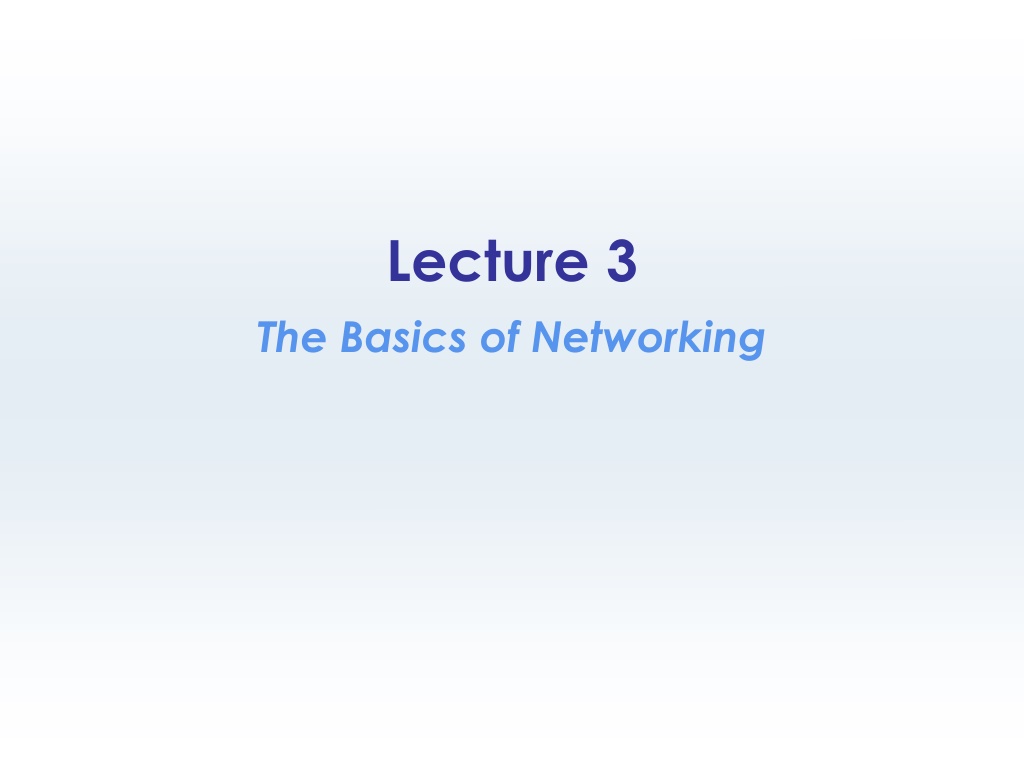
 undefined
undefined





